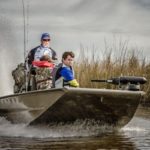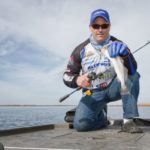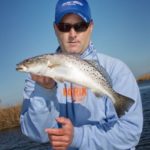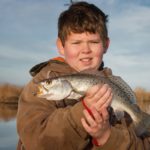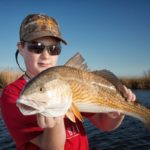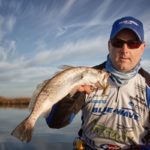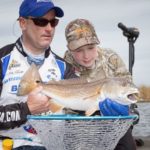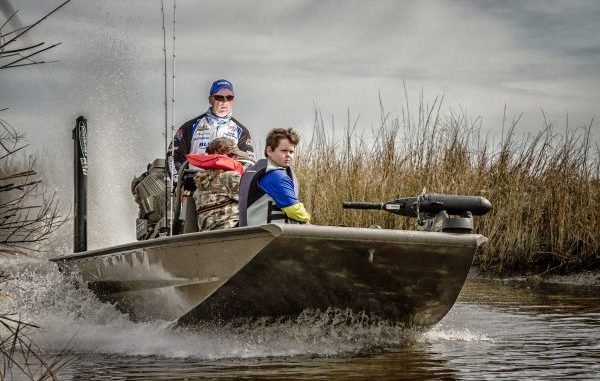
Bay boats are great plaforms from which to fish, but this DuLarge guide also has a mud boat on hand to reach trout and reds big-boat anglers can’t this month.
Marty LaCoste likes things a little quiet.
According to my son, it’s so he can whisper to the fish exactly what he wants them to do.
When things get a little bit too loud, those trout can’t hear him as clearly.
That’s why the “Trout Whisperer” — my son’s nickname for LaCoste — went out and bought an 18-foot-by-60-inch Gator Tail aluminum boat with a mud motor on back.
Even with a 24-foot Blue Wave bay boat hanging in a slip down at Bayou DuLarge, LaCoste wanted something that would allow him to be heard more clearly.
This past winter, LaCoste didn’t have all the peace and quiet he desired.
Hardly a day went by that he didn’t put his customers on limits of speckled trout with some lagniappe redfish thrown in.
The only problem, if there could be a problem with catching limits of speckled trout, was that he fished in a parade of boats that destroyed his trout tranquility.
LaCoste cut to the chase when I met him on the other side of the levee at the end of 315.
“I can get into places that guys in the big boats could never even think about fishing,” he insisted.
Actually, LaCoste purchased a Gator Tail mud boat mostly for wintertime fishing. Although it was difficult to hear him with so many layers over my ears and the constant chop of the motor, he elaborated a little bit as we made our way down Bayou DuLarge.
“From about the middle of November to the end of March, the redfish and trout stack up in deep water in the marsh,” he said. “The problem is you’ve got to cross some really shallow water to get to those deep holes.”
Because the motor on his Gator Tail is air cooled, LaCoste can run right over mud flats in mere inches of water without having to worry about sucking up a cooling-system full of mud and the resulting overheated motor that is sure to follow.
These are areas where a small aluminum boat with an even smaller outboard would struggle.
Like all Gator-Tail motors, LaCoste’s propeller is off set on a 90 degree angle from the motor’s lower unit rather than continuing to stick straight down into the water.
“The prop kind of angles out and runs just below the surface,” he said. “And I don’t know what that propeller is made out of — some kind of hardened steel — but it can take a beating.”
Almost as if on cue, the sound coming from the back of LaCoste’s mud boat sounded like it was seriously getting shredded.
He didn’t seem too concerned, so I turned around to check it out. His rooster tail was full of flying oyster shells that his motor was slinging into the air.
As soon as we got to the deeper hole on the other side of this shallow oyster flat, LaCoste had me inspect the prop to see if it had any dings.
Not a one.
We readied our fishing gear and started casting toward the deep hole in the general direction LaCoste was pointing.
“There are some areas in the Bayou Savant area that a lot of people fish,” LaCoste said. “When you’re running down Bayou DuLarge, most people take the first left at The Jump to get there.”
The Jump is two little ponds boaters have to cross when they take the first left that LaCoste pointed out some anglers might know better as The Field Goal. In either case, it’s easy to spot because of the two power line poles that stand taller than all the rest.
This shortcut is an awesome time saver, but it becomes nothing more than a big mud flat during low-water periods.
“When it’s really low, you can’t run The Jump at all in a big boat,” LaCoste continued. “In that case, you would have to run through Bayou Jones and through Sister Lake to get to Bayou Savant.”
A mud boat keeps the short cut in play even when the water is low.
The water typically falls out after a big cold front comes through South Louisiana. The resulting north wind just blows it all out to the point that not even a rising tide can fight back.
“We’ve had some water so low this past winter we had a negative tidal range,” LaCoste pointed out. “We saw ranges like -1 and -1.5. When you see that, there’s just no water around. Whatever was water is nothing but mud with those negative tides.”
To figure out what tidal range he will be facing, LaCoste relies on a buoy located in Sister Lake which can be accessed through the Internet with a quick search for “Sister Lake buoy” or the use of a smart phone tide chart.
Even though his Gator Tail allows him access to areas where others can’t go, LaCoste still likes to leave the dock a little bit earlier than normal to account for his only being about to move down the bayou at 25 mph rather than 40.
“Normally during the winter, you don’t really have to leave the dock all that early,” LaCoste noted. “A lot of people like to wait for the sun to come up and warm the water before they even leave. Not me — I like being the first one out there, so I leave early anyway and even earlier when I’m running the Gator Tail.”
The good thing about running a mud boat out of Bayou DuLarge is that most of the entire area is protected marsh. There may be a few open bays to traverse, but a mud boat makes it easy to run the lee side without much fuss.
“Now somebody that launches out of Falgout Marina has to cross Lake Decade,” LaCoste mentioned. “If that’s you, you’ve got to know the conditions before you take off. You don’t want to cross a big lake if the weather is rough and windy. These boats aren’t made for that.”
LaCoste was filling my head with so much information that in the processing of all this knowledge, I hardly realized that he was slinging a trout into his Gator Tail on just about every cast.
As I opened his K2 Cooler for him to toss in another one, I mentioned how surprisingly well his mud boat was set up for fishing.
“I got this boat to fish, duck hunt and bow fish,” LaCoste said. “When I thought about the fishing part, I realized I might have to scale back on some of the gear I regularly carry in my Blue Wave. I originally set it up for fishing three people.
“That’s why I’ve got it rigged with three rod holders on each side of the console. There is a lot of storage in this boat, but you’ve got to learn to carry only what you need rather than every bait known to man. I could put more if I wanted, but I like to eliminate unnecessary weight.”
For LaCoste, this bring-only-the-necessities approach means he can catch limits of trout and redfish on a single lure — a Matrix Shad.
In fact, over two days of fishing, we probably only went through four or five of the Green Hornet colored Matrix Shads, and that was with two adults and two kids fishing.
“I may throw in some gold spoons if I think I’m going to be sight casting redfish,” he went on, “but I proved to myself last year that a Matrix Shad is as good as it gets down here, and it doesn’t discriminate because the trout and reds love ‘em.”
LaCoste got the extended front deck in his Gator Tail, but he also included one K2 cooler for his fish box and one for his drink cooler that also serves as the console seat.
These two coolers do double duty because they are so sturdy that anglers can stand directly on top of them as fishing platforms without fear of them crumpling underneath.
In the end, a small mud boat is an ideal boat for anglers who frequently fish out of Bayou DuLarge.
“A do-it-all boat,” LaCoste called his.
So if you’re looking for an all-purpose boat that allows you to do everything you love to do on the water without having to buy three separate boats, take LaCoste’s advice and look into a mud boat.
Not only will you get everything you want wrapped up in one neat little package at a price that won’t break the bank, you’ll also keep more of your money in your pocket when you get ready to fill it up.
“Four gallons,” LaCoste answered when I asked him how much fuel we had burned round trip. “In my big boat, this same trip would have burned 12 to 15 gallons.”
With that kind of economy, LaCoste can quietly whisper to more trout more often.
Contact Capt. Marty LaCoste with Absolute Fishing Charters at 985-856-4477 or visit www.absolutefishingcharters.com for more information.
